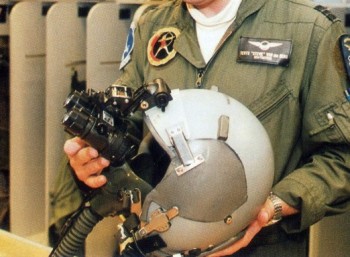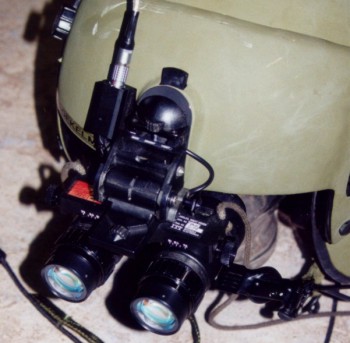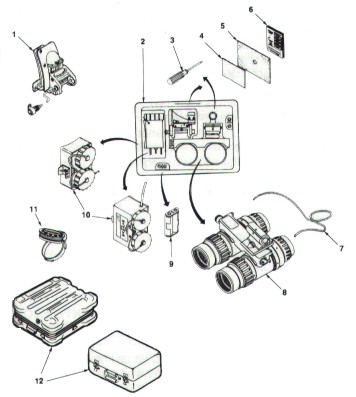AN/AVS-6(V)1
and 2, AVIATOR'S NIGHT VISION IMAGING SYSTEM (ANVIS)
For modern day aviators, the working day does not end at 5 o clock anymore. Operations are
carried out twenthy four hours a day. To aid the pilot while flying in night time
conditions, a lot of air arms are using some sort of night vision equipment. The USA and
some of its NATO partners are using the AN/AVS-6 system.
Binocular Assembly
The binocular assembly consist of two identical monoculars mounted under a pivot-and
-adjustment shelf (PAS). The monoculars can be moved in different ways to adjust them to
the eyes. The monocular consist of three subassemblies. One objective lens assembly, one
monocular housing with image intensifier and an eyepiece lens assembly. The binocular
assembly is mounted to the helmet by means of a visor-guard mount (AN/AVS-6(V)1) or offset
mount (AN/AVS-6(V)2). A neck cord is used to prevent the visor from falling.

Visor Intergrated Mount
For operations on the SPH-4 Helmet, the standard visor guard can be removed and replaced.
This replacement visor housing contains some adjustments for the use of the ANVIS. The
bottom of the intergrated mount on the visor housing has a low-battery indicator (an LED)
that gives an indication when battery life is approximately 30 minutes. The mount also
provides the electrical contacts for the binocular. A slightly different intergrated setup
is used on the SPH-5 and HGU-56/P helmets.
Offset Mount
The offset mount attaches directly to the existing visor on helmets. It contains the same
features as the mount described above.

Power Pack
There are three types of power packs. Original types can hold two lithium batteries and
the newer types hold either one lithium battery or two AA batteries. Two of the packs
attaches to the back of the helmet and one, as seen on the HGU-55/P, seems to have the
powerpack intergrated with the mount. Aicraft
power can also be used.
How does it work?
Visible light and near infra red light are passing through the lens. The beams are focused
on the photocathode and are turned up side down. When the light reflects on the
photocathode electrons are send to the microchannel plate. This plate has the size of a
nickel and consists of millions of tubes. These tubes are a bit tilted so the incoming
electrons are hitting the sides. When an electron hits something more electrons are
released. As this proces happens a couple of times, a lot of electrons are leaving the
microchannel plate. In this fase the actual intensifying takes place. The negative loaded
electrons are speeded to a phosphor screen. This speeding up increases the energy of the
electrons. The electrons reach the phosphor screen and make it glow. In this proces the
electrons are inverted to visible light. At last the image has to be turned again.
1. Offset Mount Assembly
2. Carrying Case
3. Screwdriver
4. Lens Tissue
5. Velcro Fastener
6. Operators Manual
7. Neck Cord
8. AN/AVS-6(V)2 Binocular
9. AA Battery Cardridges
10. Powerpack
11. Container/Wrench
12. Shipping & Storage Case
|
 |
Source: De Vliegende Hollander (picture HGU-55/P with
ANVIS)
|